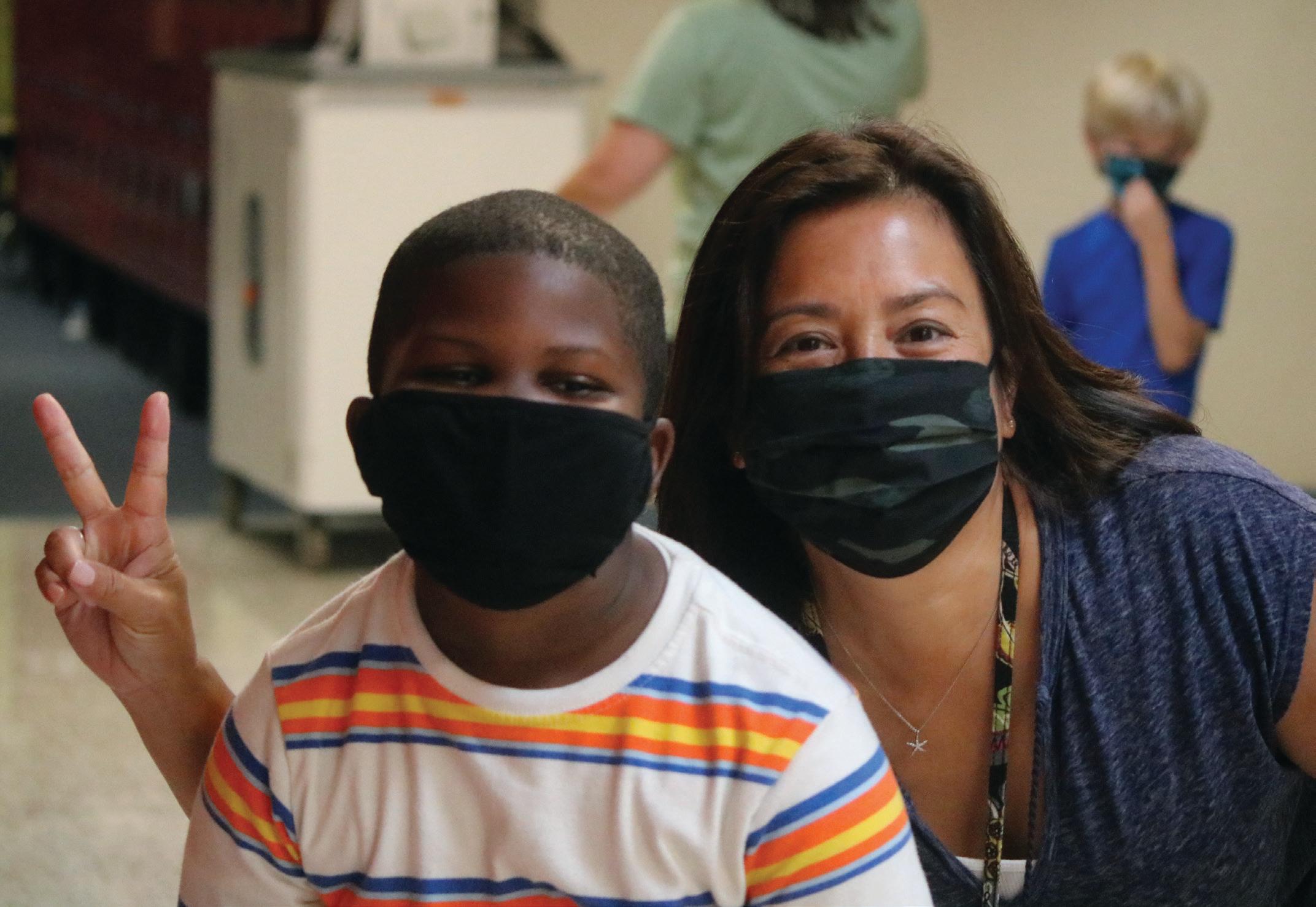
11 minute read
PANDEMIC PLAYBOOK
SYCAMORE RESPONDS TO COVID-19
BY LISA HENDRICKSON
Advertisement
How do you follow a moving target —especially one as disruptive and dangerous as the coronavirus? That’s the dilemma Sycamore and other schools have faced since early March, when the looming pandemic entered Indiana. Sycamore has managed this enormous challenge by developing a robust pandemic playbook that has enabled students to successfully continue learning both at home and at school.
On March 10, 2020, Indiana Gov. Eric Holcomb announced that 12 Hoosiers had tested positive for the virus and urged schools to “plan now for broader closures.” Head of School Diane Borgmann had already started doing her homework on COVID-19 while keeping a close eye on the growing number of cases. A Distance Learning Plan for a potential shift to virtual classes was already in the works. Borgmann met with the school’s leadership team, telling them she was nearly certain that the school would have to close because of the rapidly rising caseload. Her prediction was accurate, and she announced that the inauspicious date of Friday, March 13, would be the last day of in-person classes. She hoped the building could reopen in mid-April, following the end of the scheduled twoweek spring break. But soon after, the governor announced that all schools would be required to close indefinitely.
ABOVE: JONATHAN AMOAH, WITH 4TH GRADE TEACHER, JEAN WRIGHT
LEARNING FROM HOME
On Wednesday, March 18, Sycamore’s virtual school went online. Teachers had spent the previous few days scrambling to adapt their lesson plans to accommodate remote learning.
In preparation, Tiffany Stahl and her fellow third-grade teachers created and delivered packets to students’ homes. They divided their classes into smaller groups of six and seven, leading lessons using the Zoom videoconferencing platform. Stahl, who teaches science and math, designed hands-on chemistry experiments for her students to follow at home. “I had to think outside the box about
what I could do to have them learn these concepts,” Stahl says. As Stahl taught those concepts, teaching assistant, Cara Hermancinski, kept an eye on students’ reactions to make sure they grasped them. Students researched two elements from the periodic table in one class, then created and recorded their own lesson for classmates to watch, using a video presentation program called Flipgrid.
Stahl says the small-group lessons enabled her to differentiate according to the students’ individual learning needs, but she missed the personal interaction.
“I’m not going to say it was easy, but we got through it, and I think the kids kept learning, which was huge for me,” says Stahl. Middle School science teacher, David Schuth, agrees that the switch to online classes was a learning process, but he says his colleagues and he quickly came together to modify lessons. Schuth recorded instructional videos for his students. “I wanted
them to be able to work in-between classes,” he says, “at their own pace and at a convenient time.”
Schuth altered an in-class project in which each student built a catapult, launched an object, and attempted to hit another student’s device. Since that wasn’t possible virtually, the revised assignment required students to hurl a tennis ball via catapult or to make a vacuum bazooka that could shoot a projectile a specified distance.
“The teachers were so responsive and flexible,” says Jessica Lee, mother of three Sycamore students. She complimented the teachers on being able to individualize learning for each of her children. Eighth-grader, Sam Rudavsky, says he “wasn’t a fan of distance learning” because he missed being with friends at school. He also was concerned that he wouldn’t be able to meet with his teachers
after school or during study hall. But he was relieved to find that every teacher in his core classes offered optional “office hours” two or three times a week, during which students could log in to a Zoom conference to ask questions. He says these conferences had the additional benefit of helping friends stay in touch and remain emotionally grounded.
PLANNING TO RETURN
The school building remained off-limits to all faculty, staff and students until June.
In the meantime, work had started on the creation of the playbook that would be required for a return to in-person classes. In late May, Borgmann created the Reopening Sycamore Task Force that included 21 teachers, administrators, trustees, parents, a physician, and the school nurse. The group began its work by reviewing COVID-19 research and considering three options for the 2020-21 school year: reopening in full, remaining virtual, or adopting a hybrid approach. A trio of task force subcommittees considered facility safety issues, established health and hygiene protocols, and necessary education and learning accommodations.
For six weeks, the task force “worked relentlessly and feverishly,” says Borgmann.
If school were to reopen, classrooms and schedules had to be reconfigured. Traditionally, Middle School students move between rooms, while in the Lower School and Early Childhood, students walk through the building to go to activities. Borgmann says the task force decided to have teachers, rather than students, travel among classrooms, “so if we had a case, we might not have to shut down the whole school.”
The team members measured classrooms to ensure students
would be separated by six feet, then removed and stored excess furniture. They placed acrylic shields that separate students at work tables and desks. They turned off water fountains and
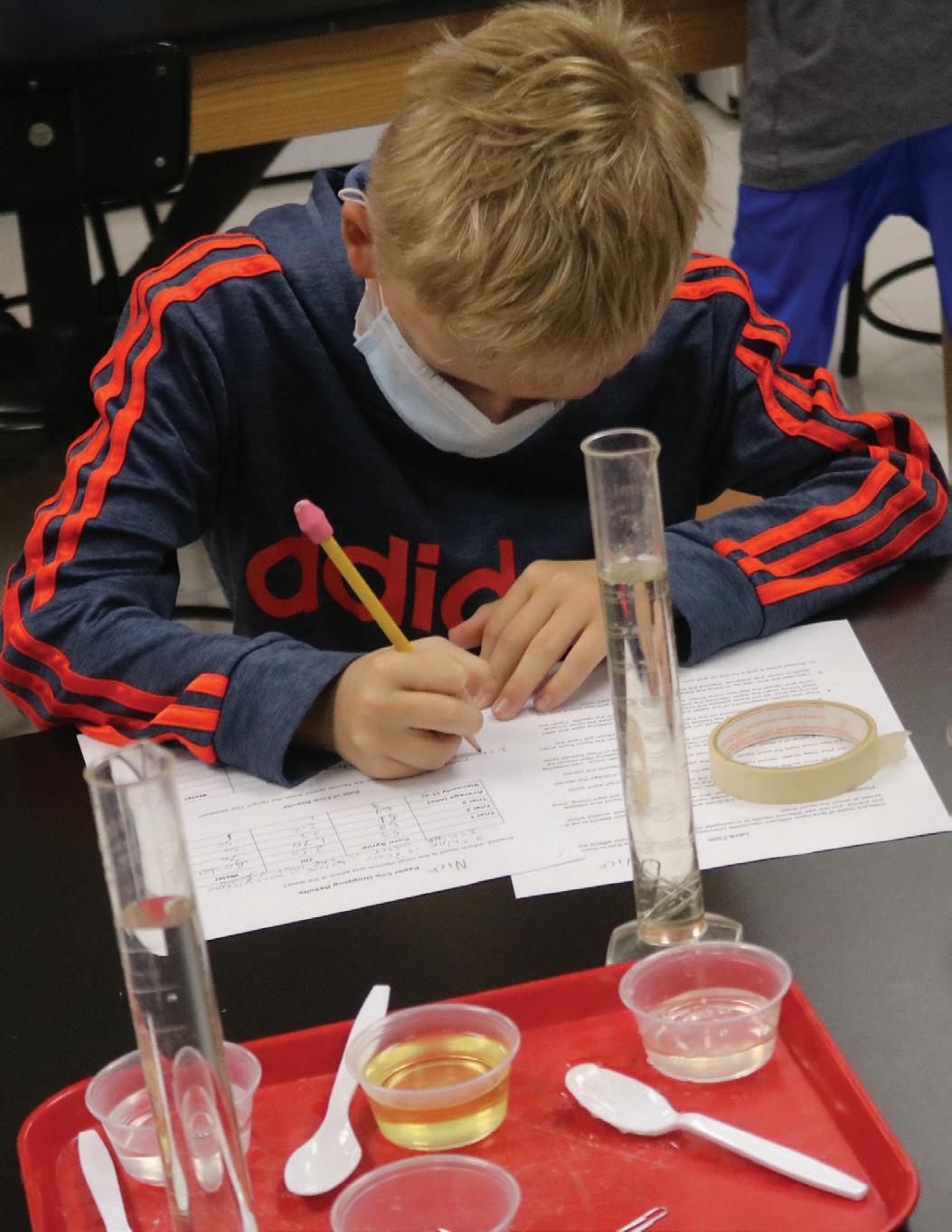
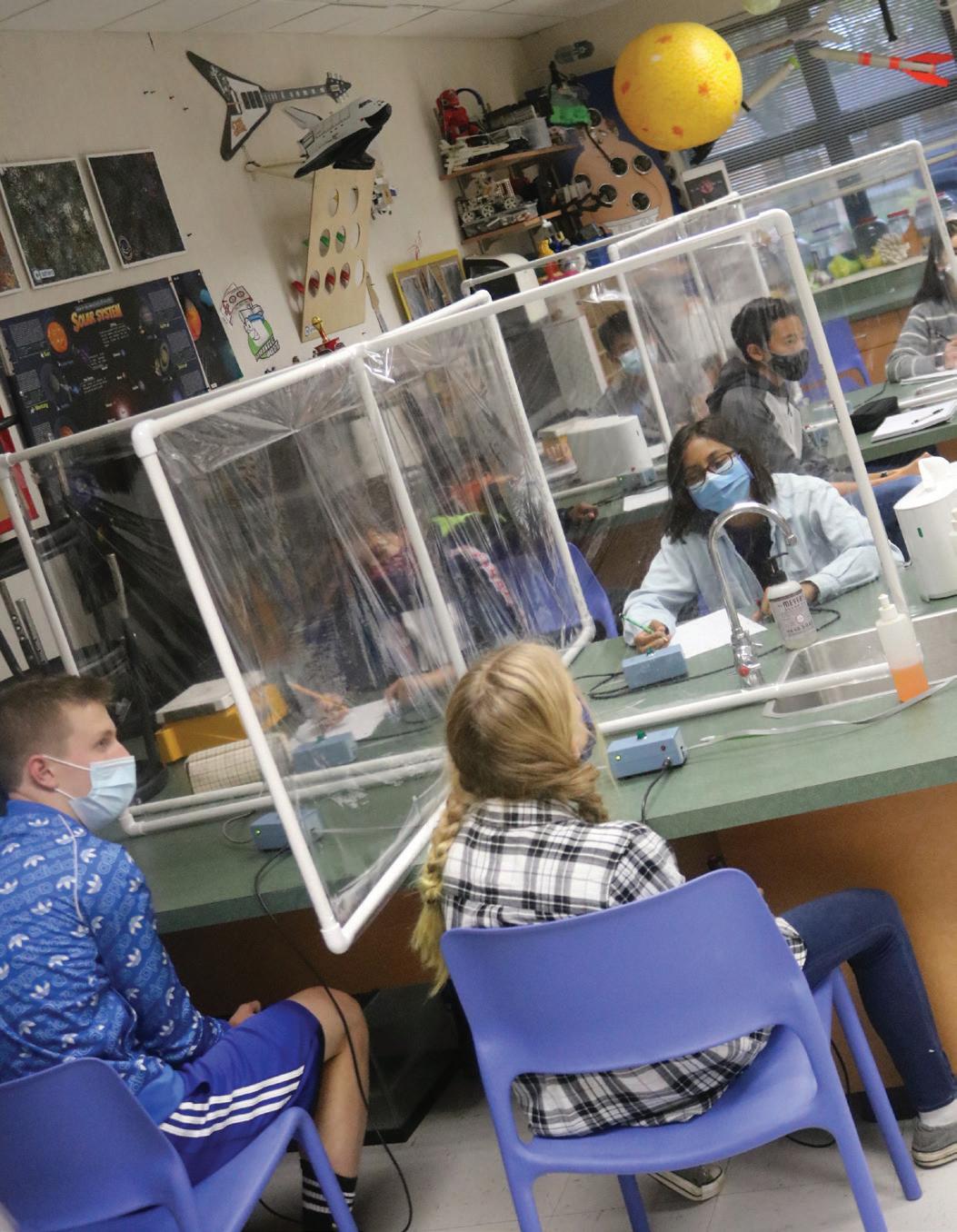
added water bottle fillers. They had ionization equipment and MERV13 filters, which filter out viruses, mold and dust installed on the school’s HVAC system, resulting in a complete air exchange every ten minutes. They stockpiled masks and hand sanitizer and marked off six-foot increments on the floors.
“We relied a lot on CDC and public health agencies. We listened carefully to the physician on our task force,” says Borgmann. “All of our efforts are aimed at risk mitigation. We know we cannot eliminate all risks.”
Dr. Rob Siwiec, who has three children at Sycamore, brought medical expertise to the committee. A gastroenterologist and professor of Clinical Medicine at Indiana University, Siwiec emphasized the CDC recommendations of masking, social distancing, hand washing, and minimizing face-touching. The task force wondered whether the youngest students would be able to keep their face masks in place throughout an entire school day. “We were able to find certain products that allowed them to have face coverings and face shields so everyone could be compliant,” he says.
Siwiec also made a presentation and conducted a questionand-answer session with faculty and staff during Welcome Back Week, helping the group think through processes and procedures and how to handle medical issues that might arise.
On July 10, the school published its Reopening Plan. But that weekend, coronavirus numbers began to climb again. Borgmann says the task force considered altering the school calendar to push the opening date from August 13 to September 8 but decided to remain with the original schedule. The Administrative Leadership Team also developed a set of metrics to gauge if and when school should return to virtual learning, unless a governmental mandate required closure. The metrics include a weighted, seven-day rolling average of COVID cases per 100,000 people and the percentage of positive tests in Marion and Hamilton counties, where 85 percent of Sycamore families live.
ABOVE LEFT: FOURTH GRADER STUDENT, NICK HARTSOCK, WORKING ON EXPERIMENTS DURING THE WATER UNIT. | ABOVE RIGHT: MIDDLE SCHOOL SCIENCE BOWL TEAMS PRACTICING DURING THE FALL.
BACK IN CLASS
Schuth says the first few days back at school required some adjustment by the students. “On one hand, they were excited to be back with their friends, but they had to stay apart to stay safe. After day two, the kids really perked up.” The ability to go outside for recess and let off steam helped. Drought-like conditions in central Indiana meant students could have outdoor
time nearly every day. Within a few weeks, they were were “adapting pretty well,” he notes.
Because Schuth thinks lab work is crucial to learning, he devised a way for students to work with partners, yet remain socially distanced. “It was a bit tricky,” he says, but an available resource room enabled the addition of round tables divided into four
sections by barriers. Schuth and Middle School Science Assistant, Dr. Sam Wendel, split the class in two, each taking a group into a separate room. As a result, they didn’t have to eliminate many labs.
DIANE BORGMANN, HEAD OF SYCAMORE SCHOOL
Extracurricular activities and before-and-after school care received makeovers, too. Intramural tennis, soccer, and crosscountry teams replaced interscholastic sports teams. Volleyball was canceled, but five outdoor basketball clinics were added. Over the summer, teachers offered virtual camps via Zoom, which proved very popular, reports Director of Extended Programs, Melissa Branigan.
Academic teams continued to meet virtually, as well as VEX Robotics, Science, Academic Bowl, and Debate teams. The Middle School Drama Club began meeting again. The school band practiced in person, with the horns’ openings protected by a shower-cap-like covering and masks including a slit for the mouthpiece. Masks, social distancing, and sanitizing hands and equipment were top priorities, and the only snacks served were individually prepackaged.
Before- and after-school care programs were also adjusted. Early Childhood students stayed together in one room, and the number was capped at 15, with an additional room available if needed. Lower School groups were separated by grade level. Middle Schoolers could no longer “hang out” in the Hagerman
Commons: that space was reserved for academic work, with tables divided by grade.
“We’re constantly looking at what we’re doing to make sure it’s working; and if it’s not, we change it. If we realize something won’t work, we cancel it,” says Branigan.
MASKS AND SOCIAL DISTANCING
Tiffany Stahl says that before school reopened, she was concerned whether students could adapt to wearing masks all day, but it didn’t turn out to be a problem. She helped ease the transition by spending the first two days of in-person classes talking to her students about the ways in which school would be different and how some aspects would remain the same. “I think that helped,” she says, adding that both students and parents understand the importance of masks. “Parents are great about keeping their kids home [if they are ill] just to play it safe.” Students who stayed home could still participate via Google Classroom.
Branigan says students became so used to the protocols that “their masks are on; they know the times when they can take them off.” (At school, they’re only allowed to remove masks when they’re outside and socially distanced or when eating and drinking.) “It is interesting to see the kids self-monitor and monitor each other,” she says. A lot of times we’ll hear students say, ‘You need to keep your distance, or you need to pull your mask up.’”
Jessica Lee adds, “They’re very willing to sacrifice things to be safer so they can stay in person. They’ve become very flexible.” Dr. Siwiec agrees. “Not once have I heard them complain about having to wear a mask,” he says. “The Sycamore spirit is definitely alive. Everyone is on board and taking this seriously.”
THE BEST-LAID PLANS . . .
“Everything we have published includes the caveat, ‘This can change at any minute,’” Borgmann said in late October. And in midNovember, it did change. Although Sycamore had not had any cases since in-person classes resumed, Indianapolis Mayor Joe Hogsett announced that all Marion County schools would be required to close again by November 30 because of the rapidly increasing COVID positivity rates. With one round of virtual classes already under their belt, it was time for Sycamore to shift to round two.
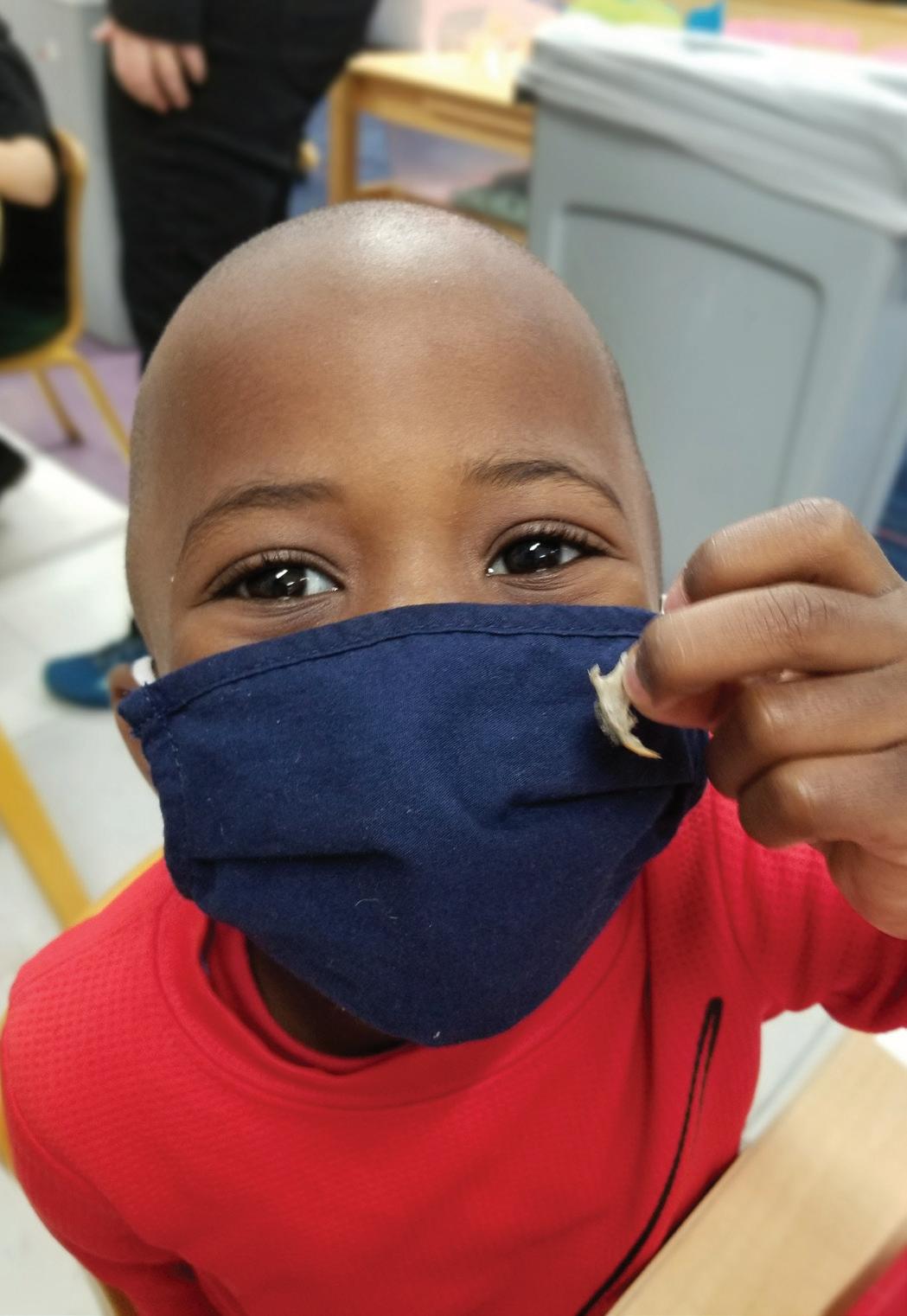
KEEPING THE FAITH
Teachers, parents, and students agree that spirits remain high despite the necessary restrictions. Although parents have not been permitted to enter the school building, “I am proud that our parents have really kept their upbeat attitudes and are always trying to find ways to keep this small school family united,” says Wendy Reymer, President of the Sycamore School Association. The organization planned outdoor, socially distanced coffee “meet-ups” on the school grounds, and parents in each grade level got together for outdoor activities. Food trucks have delivered doughnuts and shaved ice treats for both students and teachers.
ABOVE: KINDERGARTEN STUDENT, ISSA LOUIS, SHOWS OFF HIS FIND DURING THE OWL PELLET DISSECTION.
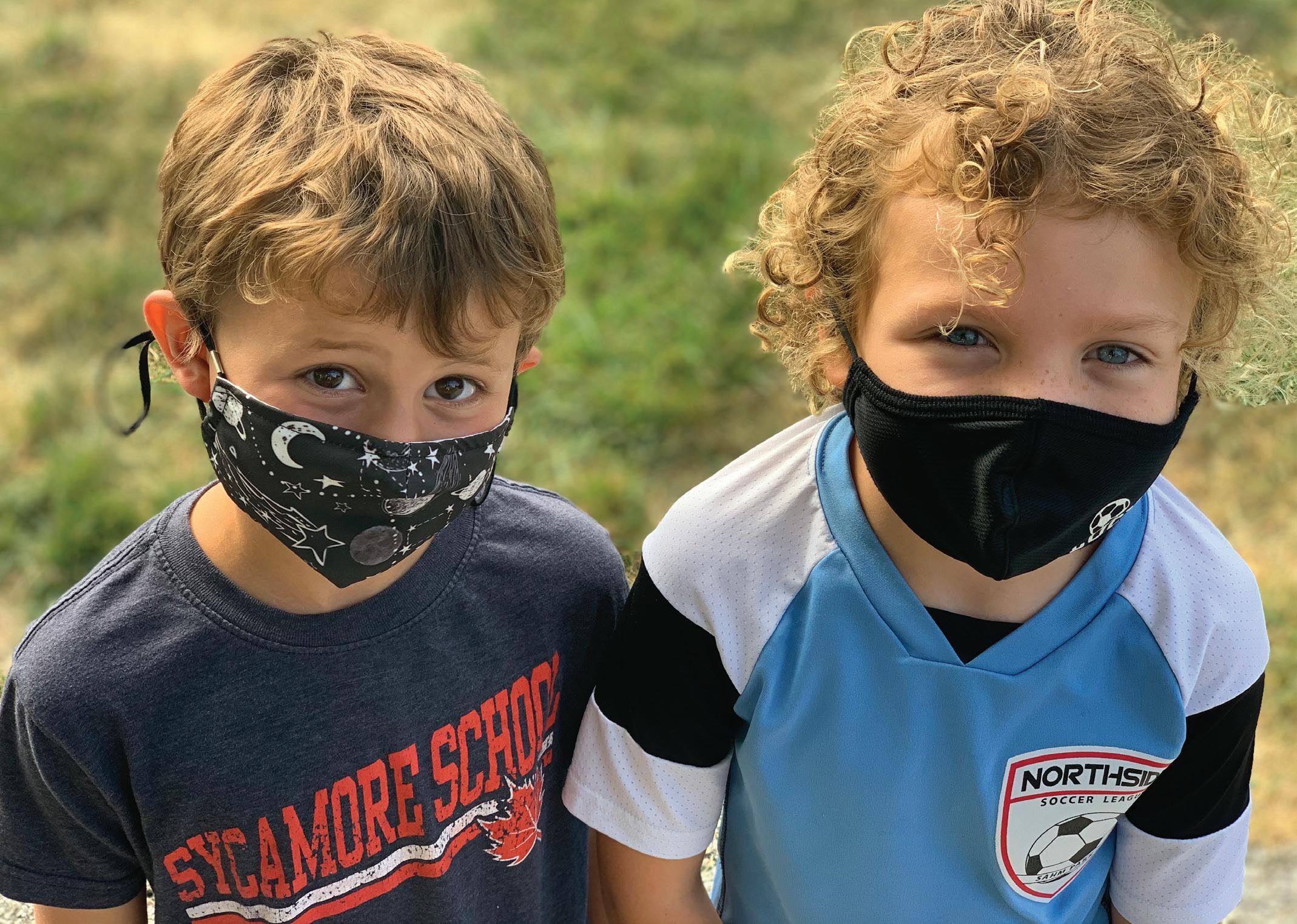
Parents also have shown support by writing messages to students and teachers on sidewalks with chalk, sending notes and cards, and providing snacks and meals for teachers during conference times and Parent Information Nights.
“Teachers have done a great job communicating regularly and posting pics, so parents can feel comfortable their kids are safe each day and enjoying learning,” Reymer says.
“Knowing we are all in this together is what has gotten us this far,” she adds. been very patient and understanding with the protocols.” Jessica Lee adds that she’s very grateful for the effort teachers have made to ensure students understand their lessons, going the extra mile by arranging after-hours Zoom chats.
Third-grader, Violet Pangan, says that while she missed her friends and teachers while learning from home, as well as giving and receiving hugs at school, “I like that they are keeping us safe.” Her mother, Catherine Pangan, adds, “I think everybody’s
ABOVE: THIRD GRADERS ISAAC REXFORD AND LUCY BAKER Although Sam Rudavsky says he’s sorry that he and his classmates will miss the annual eighth-grade spring trip to Washington, DC, he doesn’t feel too bad about it. “During coronavirus, I’m just thankful to have my friends and family be alive and uninjured. I’m just very grateful for every day I get at Sycamore.”
For additional details about Sycamore’s COVID-19 plan, visit: https://www.sycamoreschool.org. n









